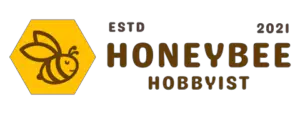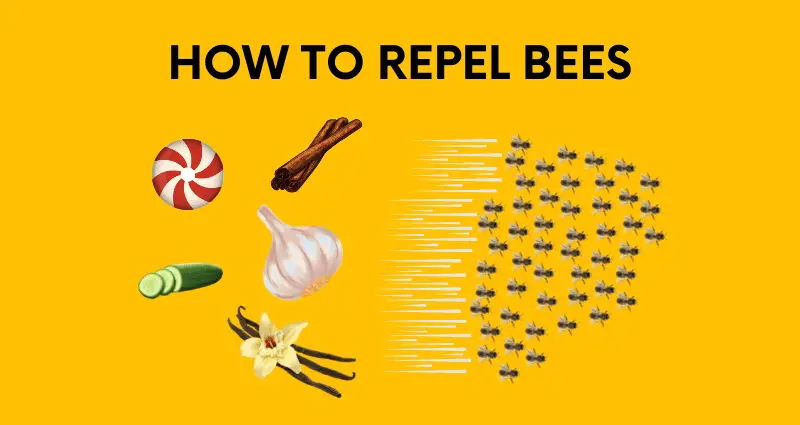Naturally-repellent plants such as peppermint, basil, eucalyptus, citronella, pennyroyal, and lemongrass are the easiest and most humane ways to keep bees away from specific locations on your property. Do not plant flowering plants with heavy nectar and pollen output.
But first, before we dive into all the ways to repel bees, we’d like to note a few things;
- Most bee species aren’t aggressive unless provoked.
- Bees contribute significantly to our environment and food supply.
You should consider ways to live with the bees first for these reasons. Please DO NOT call an exterminator out of convenience before trying natural and humane ways to deter bees from your home.
Let’s dive into some of the best ways to keep bees away.
Why are bees attracted to my home?
There are many reasons why a bee might be attracted to your deck, feeders, sheds, garden, or pool.
From bright colors like violet, blue and yellow, uncovered food and drinks during grilling season, and flowering plants. We’ll start with a list of flowering plants that attract bees;
- Lavender
- Lilacs
- Sunflowers
- Black-eyed Susans
- Beebalm
- Aster
- Coneflowers
- Zinnia
- Solidago
- Milkweed
- Cosmos
- Phlox
- Daisies
- Anise hyssop
- Sumac
- Nasturtiums
- Goldenrod
- Borage
- Lupine
- Pansies
- Peonies
























Click here for more information on the types of plants that help produce the best honey.
So the first step in preventing bees from visiting your property is to focus on garden plant selection and keeping your property clear of food, trash cans, and bright-colored items that might resemble flowers.
Plants & Flowers That Bees Don’t Like
There are a variety of flowers that bees don’t like. For example;
Red Flowers
The color red appears black to bees, so flowers like poppies, canna lilies, zinnias, celosias, and peonies are all great options.
NOTE: Marigolds have a strong scent that helps keep bees away, but the bright orange, red, and yellow flowers can also attract them. For this reason, we recommend staying away from Marigolds altogether.
Low Scent Plants
The scent of a flower is one of the primary ways they attract bees. Choose flowers with less fragrance like; ranunculuses or dahlias.
Avoid Blue, Violet, and Yellow Flowers
Yellow, violet, and blue are the colors bees are most attracted to. Stray away from plants that feature flowers with these colors.
Flowering Plants
Limiting the number of flowering plants used in your garden is a great way to avoid attracting bees and other pollinators.
However, this approach is not always practical or desirable for homeowners. Many flowering plants are necessary for pollination and producing fruits and vegetables.
There are several ways to limit flower production without harming the plants, such as using netting or cages to protect blooms from access by bees or trimming off flowers before they have a chance to bloom.
Trumpet Flowers
Stick with plants that have a trumpet-like shape. This shape makes it difficult for bees to capture the pollen or nectar, so they usually stay away from them. Flowers such as narcissus, honeysuckle, amaryllis, and buttercup, are all great choices.
Peppermint
Bees dislike the scent of peppermint, making it a fantastic addition to your herb garden or a supplemental plant to scatter around your entire garden.
Cucumber
Cucumber contains a fair amount of acid that deters bees and wasps from buzzing around. Try scattering cucumber peels around your garden to have the same effect as planting a cucumber plant.
Cloves
The spicy scent of cloves is another way to deter bees from specific areas of your home. Similar to cucumber peel, try scattering cloves around target spots.
Plants To Avoid Altogether
At Honeybee Hobbyist, we want to ensure the bee population flourishes. For this reason, please avoid specific plants that can kill bees or turn their honey toxic.
For example, rhododendrons are toxic to bees, and the honey produced by rhododendron nectar can make it unsafe for humans to consume. Other flowers include oleander and azaleas.
Bee Repellents
The most popular types of bee repellent are the spray-on type. However, granules, gels, and traps can keep away bees from your yard.
When using bee repellent, it is essential to read the instructions carefully and follow them strictly. It is also important to remember that not all bee repellents are effective against all types of bees.
Apple cider vinegar is an easy DIY natural insect repellent.
Mix apple cider vinegar with water in a spray bottle and apply it to the yard. The theory is that the vinegar confuses the bee’s sense of smell and makes your garden or pool less appealing to them.
However, be sure not to use it on plants you’ll eat later– the acidity may damage foliage.
Essential Oils, Perfumes & More
We already talked about peppermint and cloves, but what other scents might help prevent bees from coming around?
Cinnamon
By sprinkling cinnamon around areas you want to prevent bees from exploring, there’s a possibility you will deter them from returning.
Garlic
A spray of crushed garlic and water is an excellent spritz, or consider crushing garlic cloves and scattering them around the garden. It’s best not to use this in the home unless you absolutely love the smell of garlic!
Essential Oils
Heavy oils like cedarwood, clove, eucalyptus, or citronella can easily deter bees from specific areas.
Baby Oil
Baby oil mixed with water in a spritz bottle can be applied to the skin to prevent bees from buzzing around people.
Vanilla Extract
Vanilla extract mixed with water can be spritzed indoors and outdoors to deter bees.
Organic Baby Powder
Sprinkle natural/organic baby powder around your property to help keep bees away. Some baby powder options may not work, so opt for the natural stuff if available.
Mothballs
Mothballs spread around a garden bed, or placed in mesh bags around the yard, is a great option to prevent bees from targeted areas. The unpleasant odor helps deter bees and other pests from coming around.
Dryer Sheets
Similar to mothballs, the odor of dryer sheets should keep bees away from your property.
Smoke
There’s a reason why you see beekeepers puff smoke in and around their beehives. And there’s no reason you cannot use a similar tactic.
Consider installing a fire pit or burn pile on your property.
Moving A Swarm or Natural Hive
If you find that a natural colony has developed nearby, causing an infestation on your property, please don’t fret!
Your goal shouldn’t be to get rid of bees. It should be to move the colony to a safer space.
And the good news is that plenty of local beekeepers and apiarists are willing to do just that.
Buying bees is a common practice for beekeepers, so reach out to a local beekeeping club and offer the swarm to its membership. They have the know-how and capability to remove and transport swarms of bees safely.
How To Keep Bees Away From Hummingbird Feeders?
The sweet sugar water that hummingbirds love may also attract varying types of bees. Here are a few quick tips to prevent bees from enjoying your hummingbird feeder;
- Attach an ant moat or use feeders with built-in ant moats.
- Slip nectar guard tips over hummingbird feeder holes.
- Periodically move your feeders.
- Plant bee-and hummingbird-friendly flowers.
How To Keep Bees Away From A Pool?
Bees need a source of water to support their colony, which means your beautiful swimming pool attracts them like a magnet.
Not to worry, though; here are some easy steps to take to keep bees away from your pool;
- Provide an alternative water source like a strategically placed bee watering station.
- Surround your pool with a selection of the natural items listed above.
- Turn on the pool jets. The waves and disturbance of air above the water should prevent them from landing on the water.
What Smells Do Bees Hate?
Bees have a highly developed sense of smell and use it to detect threats, communicate with other bees, find food, and orient themselves. So it’s safe to say that bees don’t like any smell that interferes with their ability to do those things.
One of the smells that bees hate is citrus. You’ll often see citrus fruits used as bait to lure away honeybees from areas where they’re not supposed to be.
Other potent ones include vinegar, bleach, and ammonia. These smells can be incredibly irritating to bees. That’s why they are a sure way to keep off bees from your yard.
However, the scent of barbecue is compelling for bee colonies and wasps as well. Luckily, peppermint, spearmint, and eucalyptus scent often keep off bees from where they are unwanted.
NOTE: The pheromone humans excrete when they are afraid often causes bees to feel threatened. It’s important not to feel fear, stress, or anxiety around bees to ensure they do not swarm or sting. To learn more about how bees smell fear, click here.
How Do You Keep Bees From Attacking?
It is essential to understand that not all bees are aggressive. Beekeepers understand that bees are quite docile and will not attack unless you threaten them.
You can do a few things to help keep bees from becoming threatening.
- Keep your distance if you see a beehive, and make sure there is no exposed food or drink around that could attract the insects.
- Install a beehive. Bees are more likely to sting when threatened, so they will be less likely to attack if they have a home and a queen bee to protect.
- Wear dull clothing. Bees are attracted to bright colors, so they are less likely to notice you wearing dark colors.
- Run away if you are near a beehive and see a swarm of bees heading your way! Swarms are typically just looking for a new place to live, and they will not attack if you are not threatening them.
If you suffer from a bee sting, removing the stinger quickly using a pair of tweezers is crucial. Also, apply ice to the area to reduce swelling and discomfort. Click here to learn how to treat a bee sting.

